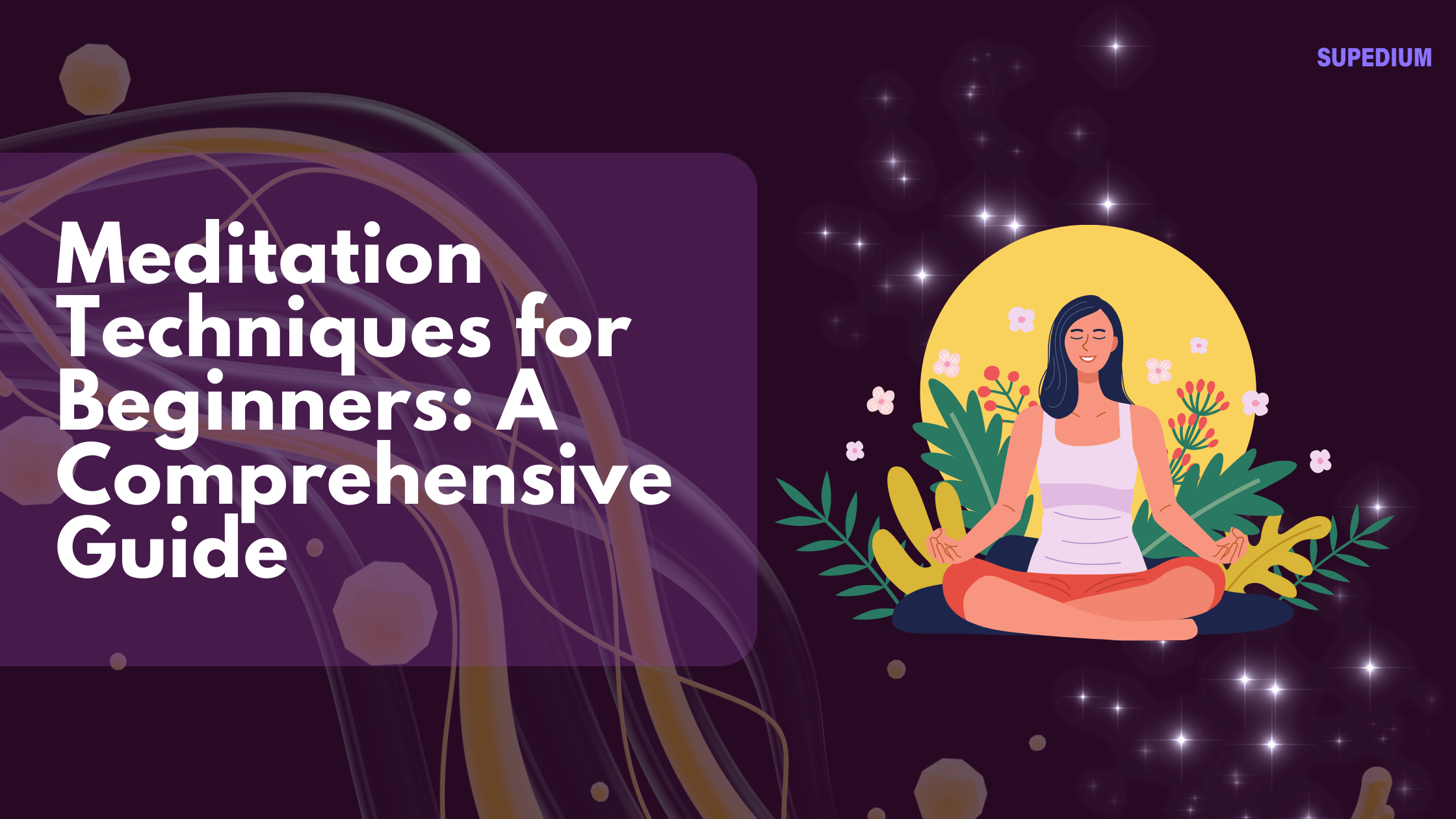Table of Contents
![]()
Meditation is a practice that has been embraced across cultures and traditions for thousands of years. It is a technique designed to foster a sense of inner peace and clarity by focusing the mind and calming the body. For beginners, starting a meditation practice can be both exciting and daunting. Understanding various meditation techniques and how to implement them can greatly enhance your experience and benefit from meditation. This guide provides a detailed overview of meditation techniques for beginners, covering everything from preparation to overcoming common challenges.
Introduction to Meditation
Definition and Benefits
Meditation is a practice of focused attention and mindfulness that aims to achieve a mentally clear and emotionally calm state. It involves training the mind to observe thoughts and sensations without judgment. Meditation has a long history, with roots in ancient spiritual and philosophical traditions, including Hinduism, Buddhism, and Taoism. Today, it is widely practiced for its numerous benefits, including stress reduction, improved concentration, emotional stability, and overall well-being.
Importance of Learning Meditation
Learning meditation can have a profound impact on mental health by reducing symptoms of anxiety and depression, enhancing emotional resilience, and fostering a greater sense of self-awareness. Physically, it can lower blood pressure, improve sleep quality, and boost the immune system. Emotionally, meditation can help manage stress, increase empathy, and improve relationships.
Overview of Different Techniques
Meditation encompasses a variety of techniques, each with its own unique approach. Beginners should explore different methods to find one that resonates with them. Common techniques include mindfulness meditation, focused attention meditation, body scan meditation, loving-kindness meditation, transcendental meditation, and guided meditation.
Preparing for Meditation
Creating a Meditation Space
To cultivate a productive meditation practice, choose a quiet and comfortable location where you won’t be disturbed. This space can be a corner of a room, a designated meditation area, or even an outdoor space. Use props such as cushions, chairs, or blankets to create a comfortable seating arrangement. The goal is to establish an environment that promotes relaxation and focus.
Setting a Schedule
Consistency is key in developing a meditation practice. Start with short sessions, such as 5 to 10 minutes per day, and gradually increase the duration as you become more comfortable. It’s helpful to meditate at the same time each day to build a routine, whether it’s in the morning, during lunch breaks, or before bedtime.
Mindset and Expectations
Approach meditation with an open mind and realistic expectations. Understand that meditation is a skill that takes time to develop. It’s normal for the mind to wander, and the goal is not to eliminate thoughts but to observe them without attachment. Patience and persistence are crucial as you build your practice.
Basic Meditation Techniques
Mindfulness Meditation
Mindfulness meditation focuses on being present in the moment. Begin by finding a comfortable seated position and gently close your eyes. Bring your attention to your breath, observing the sensation of each inhale and exhale. When your mind wanders, gently guide your focus back to your breath. You can also practice mindfulness by paying attention to bodily sensations or the sounds around you.
Focused Attention Meditation
This technique involves concentrating on a single object or thought. Choose a focal point, such as a candle flame, a mantra (a repeated word or phrase), or an image. As you meditate, keep your attention fixed on this object. If distractions arise, gently redirect your focus back to your chosen focal point.
Body Scan Meditation
Body scan meditation involves systematically paying attention to different parts of the body. Start by lying down or sitting comfortably. Close your eyes and focus on one area of the body, such as your feet. Gradually move your attention upward, observing sensations and releasing tension in each part. This practice helps develop body awareness and promotes relaxation.
Loving-Kindness Meditation (Metta)
Loving-kindness meditation aims to cultivate compassion and love for oneself and others. Sit comfortably and focus on generating warm, loving feelings. Repeat phrases such as “May I be happy,” “May I be healthy,” and “May I be at ease.” Then extend these wishes to others, including loved ones, acquaintances, and even people you find challenging. This practice fosters a sense of connection and empathy.
Transcendental Meditation
Transcendental Meditation (TM) involves the repetition of a specific mantra—a word or sound assigned to you by a trained instructor. Find a quiet place, sit comfortably, and silently repeat your mantra. TM aims to reach a state of restful awareness and deep relaxation. Practicing TM typically involves two sessions of 20 minutes each day.
Guided Meditation
Guided meditation involves following instructions provided by a guide or recording. These sessions often include visualizations or story-based narratives designed to help you relax and focus. Guided meditations can be particularly useful for beginners, as they offer structure and support in exploring different meditation practices.
Tips for Successful Meditation
Finding the Right Time and Place
Choose a time that suits your daily routine and ensures you won’t be interrupted. Morning sessions can set a positive tone for the day, while evening meditations can promote relaxation before sleep. Your chosen space should be quiet and free from distractions.
Dealing with Distractions
It’s normal for the mind to wander during meditation. When distractions arise, gently acknowledge them without judgment and return your focus to your breath, mantra, or chosen object. Developing a gentle and non-reactive attitude towards distractions will enhance your meditation practice.
Maintaining a Routine
Establishing a consistent meditation practice is essential for reaping its benefits. Use reminders, such as alarms or notes, to help you remember to meditate. Tracking your progress and setting achievable goals can also encourage regular practice.
Adjusting Techniques Based on Personal Needs
Experiment with different meditation techniques to find what works best for you. If you find one method challenging or unsatisfying, consider exploring another. Tailoring your practice to fit your personal preferences and needs will enhance your meditation experience.
Common Challenges and Solutions
Difficulty in Focusing
If you struggle to maintain focus, try techniques such as focusing on your breath or using a mantra. Regular practice will help improve your concentration over time. Remember that it’s normal for the mind to wander, and the practice involves gently guiding your attention back to your focus.
Restlessness or Discomfort
Restlessness or physical discomfort can be addressed by adjusting your meditation posture or using props for added comfort. Experiment with different positions to find one that works for you. If discomfort persists, consider incorporating gentle stretching or relaxation exercises before meditating.
Impatience and Frustration
It’s common to feel impatient or frustrated, especially when starting a new practice. Acknowledge these feelings and remind yourself that meditation is a skill that develops with time. Be patient with yourself and focus on the process rather than the outcome.
Sleepiness During Meditation
If you find yourself becoming sleepy during meditation, try practicing at a time when you’re more alert. Adjust your posture to a more upright position and ensure your meditation space is well-lit. Shortening the duration of your sessions can also help maintain alertness.
Resources for Beginners
Books and Guides
Several books can provide valuable insights and guidance for beginners. Consider reading works by authors such as Jon Kabat-Zinn, Thich Nhat Hanh, and Sharon Salzberg. These authors offer practical advice and wisdom on various meditation practices.
Apps and Online Resources
Meditation apps like Headspace, Calm, and Insight Timer offer guided meditations and tools to support your practice. Many apps provide beginner-friendly sessions and features to track your progress. Online platforms also offer a wide range of guided meditations and instructional videos.
Local Classes and Groups
Joining a meditation class or group can provide additional support and motivation. Look for local meditation centers or community groups that offer classes for beginners. Participating in a group setting can also help you connect with others who share your interest in meditation.
Conclusion
Meditation is a powerful practice that can enhance your mental, physical, and emotional well-being. By exploring various techniques and establishing a consistent practice, you can experience the profound benefits of meditation. Remember that meditation is a personal journey, and finding the right approach for you may take time. Embrace the process with patience and an open mind, and continue to explore and deepen your practice. With persistence and dedication, meditation can become a valuable tool for achieving greater peace and clarity in your life.
Share This





Be the first to comment